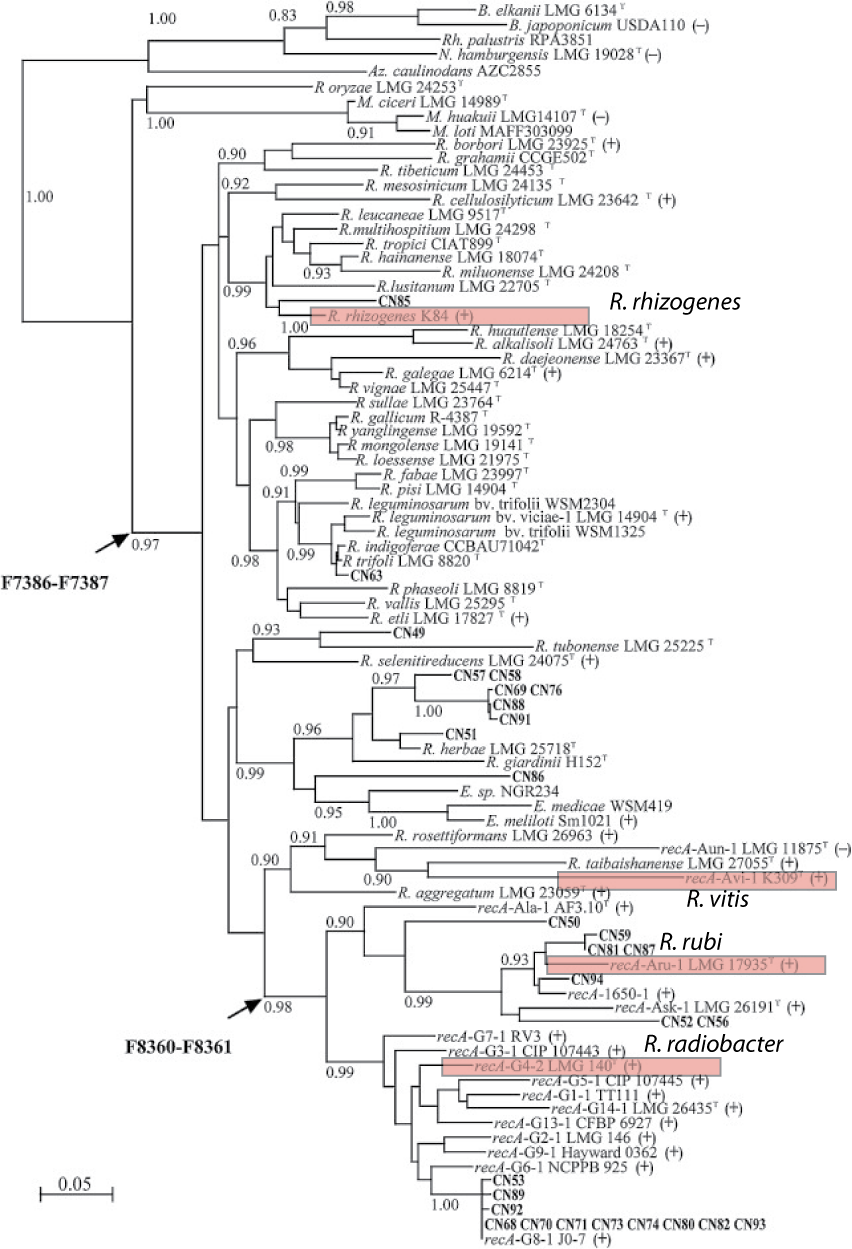
Introduction
Agrobacterium is a well-known genus in bacteriology and molecular biology, but research has shown that it cannot easily be separated from the Rhizobium genus, thus all Agrobacterium species should be renamed as Rhizobium species (the earlier name). However there has been some opposition to renaming Agrobacterium, in this article I explain the research and taxonomy, and suggest a solution.
History
The Rhizobium genus was described by Frank in 1889 as nitrogen-fixing bacteria that lived in the root nodules of plants. The Agrobacterium genus was described by Conn in 1942 to encompass plant pathogenic bacteria that caused galls and root disease.
The two genera have always been considered to be very similar and probably congeneric (Conn 1942; Graham 1964), but were still regarded as distinct until the use of DNA sequencing technology made it apparent that the two genera could not be reliably separated (e.g., Sawada et al. 1993; Williams & Collins 1993). It was also found that the biological lifestyles of symbiotic root nodule nitrogen fixation and pathogenicity were controlled by mobile DNA elements such as plasmids, and that an ‘Agrobacterium’ species could be changed into a ‘Rhizobium’ species (and vice versa) by manipulation of these mobile genes (e.g., Velázquez et al. 2005).
This culminated in a taxonomic publication by Young et al. (2001) formally proposing to make Agrobacterium a synonym of Rhizobium (Rhizobium has priority as the earlier described name). This change was not universally accepted, and was contested by Farrand et al. (2003) who agreed that Agrobacterium was polyphyletic, but supported the retention of Agrobacterium, largely on the basis that they have different phenotypic traits from Rhizobium species.
However, this opposition was rebutted by Young et al. (2003), who claimed that Farrand misunderstood the role of formal nomenclature, and failed to distinguish between formal and special purpose nomenclatures. They also pointed out that although there is good phenotypic support between species of the genera, there is not good phenotypic support between the two genera. Subsequently most taxonomic publications have used the Rhizobium name (e.g., Euzéby 2013).
A proposal was made in 2011 by the ‘Subcommittee on the taxonomy of Agrobacterium and Rhizobium’ to retain the Agrobacterium genus by only transferring the more distantly related species, A. rhizogenes, to Rhizobium.
Current status (2013)
Currently there is some confusion over whether Agrobacterium or Rhizobium is the best name to use for these bacteria. Although the taxonomic basis for the reclassification of Agrobacterium to Rhizobium is supported by some bacterial systematists (e.g., Euzéby 2013), others — particularity molecular biologists — prefer to use the Agrobacterium name with which they are familiar.
The proposal by the ‘Subcommittee on the taxonomy of Agrobacterium and Rhizobium’ would seem to provide a solution by emending the concept of Agrobacterium to a more restricted sense. However this proposal does not account for the large number of root nodule Rhizobium species recently described, some of which (e.g., R. undicola, R. aggregatum, R. taibaishanense, R. rosettiformans etc.) are encompassed by the emended ‘Agrobacterium’ clade (see Fig. 1).

Fig. 1 – A phylogenetic tree of recA sequences modified from Shams et al. 2013 showing the relationship of former Agrobacterium species (indicated in red) to other Rhizobium species
Recommendations
There is no official classification of prokaryotes because taxonomy remains a matter of scientific judgment and general agreement (Sneath & Brenner 1992). In my opinion there is insufficient evidence that Agrobacterium as a genus can be clearly distinguished from Rhizobium, and thus the two names are synonyms. The non-taxonomic terms rhizobia or agrobacteria can easily be used to describe the biological lifestyles of symbiotic root-nodule nitrogen-fixation and plant pathogenicity.
I think this topic still needs a lot more research; at a minimum we need good MLSA data from all of the type strains of the family Rhizobiaceae and rigorous phylogenetic analysis. But for now I believe the best and least confusing option is to consistently use the Rhizobium names for the ‘agrobacteria’.
Weir, B.S. (2013) Agrobacterium or Rhizobium, which name to use?, NZ Rhizobia, 27 April 2013. https://www.rhizobia.co.nz/taxonomy/agrobacterium-or-rhizobium

Comments1
Comments lost during upgrade
Sadly the comments on the page were lost in the website upgrade, but they can be viewed in the archive here: https://web.archive.org/web/20220307044322/https://www.rhizobia.co.nz/taxonomy/agrobacterium-or-rhizobium